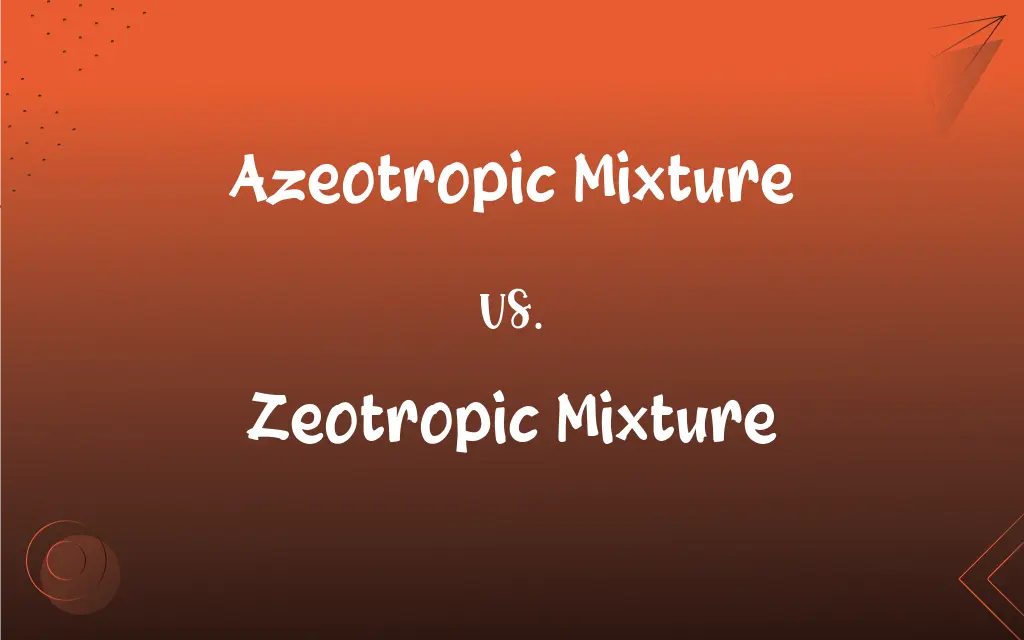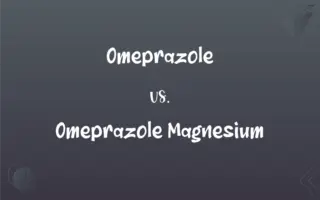Azeotropic Mixture vs. Zeotropic Mixture: What's the Difference?
Edited by Harlon Moss || By Janet White || Published on April 5, 2024
Azeotropic mixtures maintain constant boiling points and composition during vaporization, while zeotropic mixtures exhibit varying boiling points and composition changes.

Key Differences
An azeotropic mixture is a blend of two or more substances that boil at a constant temperature and maintain a consistent composition throughout the phase change. In contrast, a zeotropic mixture involves components with different boiling points, leading to a gradual change in composition and boiling temperature during vaporization or condensation.
In an azeotropic mixture, the vapor and liquid phases share identical compositions at a specific ratio, making it impossible to separate components through simple distillation. Zeotropic mixtures, however, display varying compositions between vapor and liquid phases, allowing for separation by conventional distillation, as the composition shifts during the phase change.
The behavior of azeotropic mixtures can simplify or complicate chemical processes, as they form a single boiling point like pure substances. Zeotropic mixtures, on the other hand, require careful management in processes like refrigeration, where their changing temperature-composition relationship can influence system efficiency.
Certain azeotropic mixtures are used to achieve desired boiling points or solvent properties, beneficial in industries like pharmaceuticals and perfumery. Zeotropic mixtures, with their gradational boiling points, find use in applications like refrigeration, where tailored phase-change temperatures are advantageous.
Understanding the nature of azeotropic mixtures is crucial in designing distillation and purification processes, as their constant boiling point can limit separation efficiency. Zeotropic mixtures, with their variable boiling points, offer more flexibility but require complex management in systems like refrigeration, where precise temperature control is necessary.
ADVERTISEMENT
Comparison Chart
Boiling Point
Constant throughout vaporization
Changes during vaporization
Composition
Remains constant in liquid and vapor phase
Varies between liquid and vapor phase
Separation by Distillation
Not possible to separate components
Components can be separated
Usage in Industries
Pharmaceuticals, perfumery
Refrigeration, distillation
Temperature-Composition Curve
No change (straight line)
Gradual change (curved line)
ADVERTISEMENT
Azeotropic Mixture and Zeotropic Mixture Definitions
Azeotropic Mixture
A mixture that behaves like a pure substance during phase changes.
The azeotropic mixture in the flask resisted separation despite the rigorous distillation process.
Zeotropic Mixture
A blend of substances with varying boiling points and composition during phase change.
The zeotropic mixture required careful temperature control to separate its components.
Azeotropic Mixture
A blend of substances boiling at a consistent temperature and maintaining fixed composition.
Water and ethanol form an azeotropic mixture, boiling off together during distillation.
Zeotropic Mixture
A heterogeneous mixture with variable phase change characteristics.
The zeotropic mixture presented a challenge in the separation process, demanding an innovative approach.
Azeotropic Mixture
A blend of components that evaporate or condense at the same rate.
The perfume's fragrance relied on the delicate balance of an azeotropic mixture.
Zeotropic Mixture
A chemical combination with a gradient boiling point curve.
The engineer plotted the zeotropic mixture's temperature-composition graph for precise analysis.
Azeotropic Mixture
A chemical combination exhibiting a single, constant boiling point.
Engineers utilized the azeotropic mixture's unique properties for the efficient design of the cooling system.
Zeotropic Mixture
A blend where components evaporate or condense at different rates.
Refrigerants often use zeotropic mixtures to achieve desired cooling cycles.
Azeotropic Mixture
A homogeneous mixture with uniform boiling characteristics.
The azeotropic mixture ensured a stable process in the chemical reactor.
Zeotropic Mixture
A mixture with a shifting composition between liquid and vapor phases.
The distillation column efficiently handled the zeotropic mixture, thanks to its advanced design.
FAQs
Why are zeotropic mixtures important in refrigeration?
Their varying boiling points and compositions allow for tailored phase-change temperatures, crucial for efficient refrigeration cycles.
How does a zeotropic mixture differ from an azeotropic mixture?
Zeotropic mixtures have varying boiling points and compositions during vaporization, unlike the constant properties of azeotropic mixtures.
What is an azeotropic mixture?
It's a blend of substances that boils at a constant temperature and maintains a fixed composition during phase change.
Are azeotropic mixtures used in any specific industries?
Yes, they are particularly useful in pharmaceuticals and perfumery for their unique boiling and solvent properties.
Can an azeotropic mixture behave like a pure substance?
Yes, it can mimic a pure substance during phase changes, exhibiting a single, constant boiling point.
What role does the temperature-composition curve play in understanding zeotropic mixtures?
It illustrates the mixture's changing properties, crucial for managing systems like refrigeration where precise temperature control is necessary.
What challenges do zeotropic mixtures present in distillation processes?
Their changing composition and boiling points require complex management and precise control in distillation setups.
Is it possible to create an azeotropic mixture intentionally for specific purposes?
Yes, certain azeotropic mixtures are formulated to achieve desired boiling points or solvent properties for industrial applications.
How does the composition of a zeotropic mixture change during boiling or condensation?
It varies, with different components evaporating or condensing at different rates.
Can the boiling point of a zeotropic mixture be constant?
No, it changes during vaporization, unlike the constant boiling point of an azeotropic mixture.
Can components of an azeotropic mixture be separated by simple distillation?
No, the consistent boiling point and composition of an azeotropic mixture prevent separation by simple distillation.
What should be considered when handling zeotropic mixtures in industrial processes?
The changing temperature-composition relationship requires careful monitoring and control to ensure process efficiency.
Can the composition of a zeotropic mixture be controlled during distillation?
Yes, but it requires precise temperature and composition management due to its variable nature.
What is a key characteristic of the vapor and liquid phases in an azeotropic mixture?
They maintain identical compositions, reflecting the mixture's consistent behavior during phase changes.
Is it possible to predict the behavior of an azeotropic mixture in a chemical reaction?
Yes, due to its consistent boiling point and composition, its behavior can be predicted more easily than that of a zeotropic mixture.
How do azeotropic mixtures complicate chemical processes?
Their constant boiling point can limit the efficiency of separation and purification processes.
What is the benefit of using a zeotropic mixture in a refrigeration cycle?
It allows for the design of efficient cooling cycles with tailored phase-change temperatures.
Why is it challenging to separate components of a zeotropic mixture?
The varying boiling points and compositions require sophisticated separation techniques beyond simple distillation.
Are zeotropic mixtures versatile in industrial applications?
Yes, their gradational boiling points offer flexibility in applications like refrigeration and distillation.
What makes azeotropic mixtures unique in solvent properties?
They can offer solvent properties similar to pure substances, beneficial in industries like pharmaceuticals.
About Author
Written by
Janet WhiteJanet White has been an esteemed writer and blogger for Difference Wiki. Holding a Master's degree in Science and Medical Journalism from the prestigious Boston University, she has consistently demonstrated her expertise and passion for her field. When she's not immersed in her work, Janet relishes her time exercising, delving into a good book, and cherishing moments with friends and family.
Edited by
Harlon MossHarlon is a seasoned quality moderator and accomplished content writer for Difference Wiki. An alumnus of the prestigious University of California, he earned his degree in Computer Science. Leveraging his academic background, Harlon brings a meticulous and informed perspective to his work, ensuring content accuracy and excellence.































































